SanDisk Ultra Plus SSD Review (256GB)
by Anand Lal Shimpi on January 7, 2013 9:00 AM ESTAnandTech Storage Bench 2011
Two years ago we introduced our AnandTech Storage Bench, a suite of benchmarks that took traces of real OS/application usage and played them back in a repeatable manner. I assembled the traces myself out of frustration with the majority of what we have today in terms of SSD benchmarks.
Although the AnandTech Storage Bench tests did a good job of characterizing SSD performance, they weren't stressful enough. All of the tests performed less than 10GB of reads/writes and typically involved only 4GB of writes specifically. That's not even enough exceed the spare area on most SSDs. Most canned SSD benchmarks don't even come close to writing a single gigabyte of data, but that doesn't mean that simply writing 4GB is acceptable.
Originally I kept the benchmarks short enough that they wouldn't be a burden to run (~30 minutes) but long enough that they were representative of what a power user might do with their system.
Not too long ago I tweeted that I had created what I referred to as the Mother of All SSD Benchmarks (MOASB). Rather than only writing 4GB of data to the drive, this benchmark writes 106.32GB. It's the load you'd put on a drive after nearly two weeks of constant usage. And it takes a *long* time to run.
1) The MOASB, officially called AnandTech Storage Bench 2011 - Heavy Workload, mainly focuses on the times when your I/O activity is the highest. There is a lot of downloading and application installing that happens during the course of this test. My thinking was that it's during application installs, file copies, downloading and multitasking with all of this that you can really notice performance differences between drives.
2) I tried to cover as many bases as possible with the software I incorporated into this test. There's a lot of photo editing in Photoshop, HTML editing in Dreamweaver, web browsing, game playing/level loading (Starcraft II & WoW are both a part of the test) as well as general use stuff (application installing, virus scanning). I included a large amount of email downloading, document creation and editing as well. To top it all off I even use Visual Studio 2008 to build Chromium during the test.
The test has 2,168,893 read operations and 1,783,447 write operations. The IO breakdown is as follows:
| AnandTech Storage Bench 2011 - Heavy Workload IO Breakdown | ||||
| IO Size | % of Total | |||
| 4KB | 28% | |||
| 16KB | 10% | |||
| 32KB | 10% | |||
| 64KB | 4% | |||
Only 42% of all operations are sequential, the rest range from pseudo to fully random (with most falling in the pseudo-random category). Average queue depth is 4.625 IOs, with 59% of operations taking place in an IO queue of 1.
Many of you have asked for a better way to really characterize performance. Simply looking at IOPS doesn't really say much. As a result I'm going to be presenting Storage Bench 2011 data in a slightly different way. We'll have performance represented as Average MB/s, with higher numbers being better. At the same time I'll be reporting how long the SSD was busy while running this test. These disk busy graphs will show you exactly how much time was shaved off by using a faster drive vs. a slower one during the course of this test. Finally, I will also break out performance into reads, writes and combined. The reason I do this is to help balance out the fact that this test is unusually write intensive, which can often hide the benefits of a drive with good read performance.
There's also a new light workload for 2011. This is a far more reasonable, typical every day use case benchmark. Lots of web browsing, photo editing (but with a greater focus on photo consumption), video playback as well as some application installs and gaming. This test isn't nearly as write intensive as the MOASB but it's still multiple times more write intensive than what we were running in 2010.
As always I don't believe that these two benchmarks alone are enough to characterize the performance of a drive, but hopefully along with the rest of our tests they will help provide a better idea.
The testbed for Storage Bench 2011 has changed as well. We're now using a Sandy Bridge platform with full 6Gbps support for these tests.
AnandTech Storage Bench 2011 - Heavy Workload
We'll start out by looking at average data rate throughout our new heavy workload test:
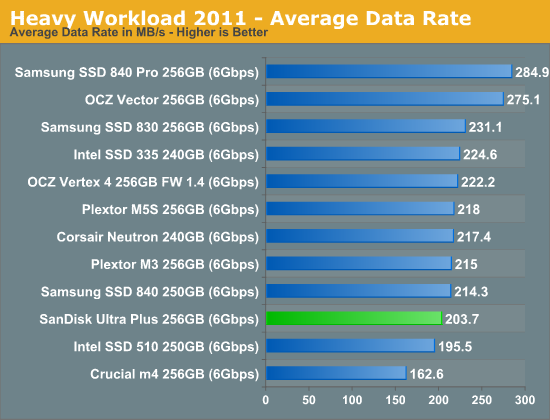
The Ultra Plus does ok in our heavy workload, hot on the heels of Samsung's SSD 840. By no means is this the fastest drive we've tested, but it's not abysmal either. We're fans of the vanilla 840, and the Ultra Plus performed similarly. Architecturally it's a bit of a concern if Samsung's TLC drive is able to outperform your 2bpc MLC drive though.
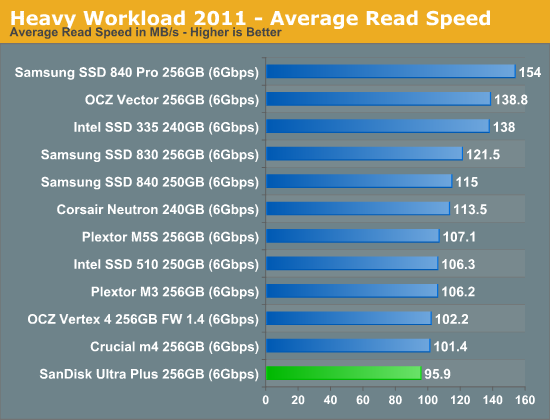
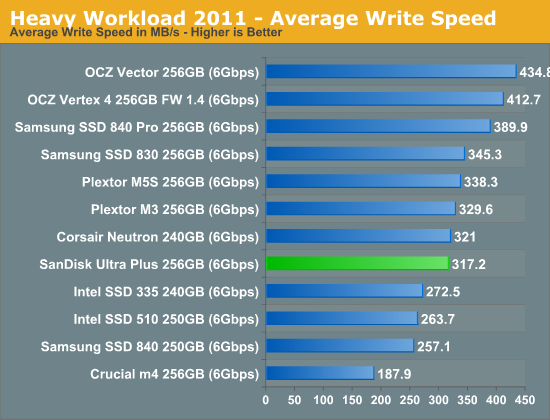
The next three charts just represent the same data, but in a different manner. Instead of looking at average data rate, we're looking at how long the disk was busy for during this entire test. Note that disk busy time excludes any and all idles, this is just how long the SSD was busy doing something:
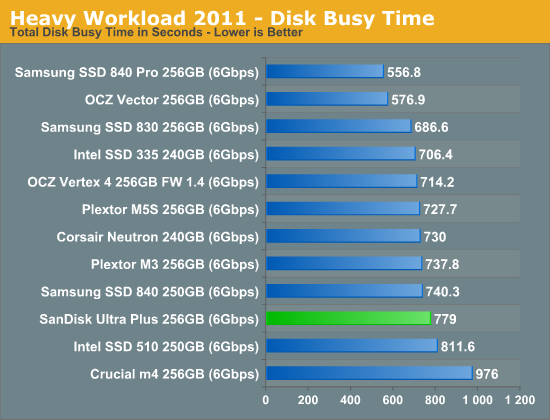
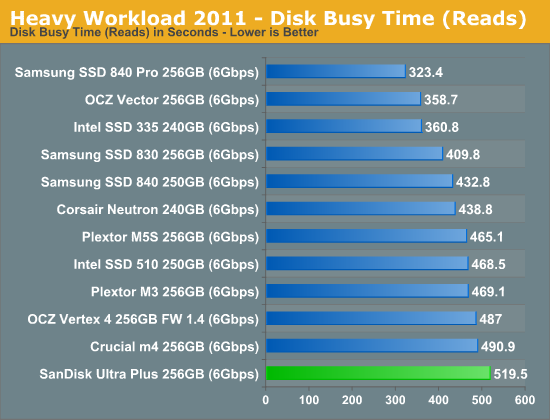
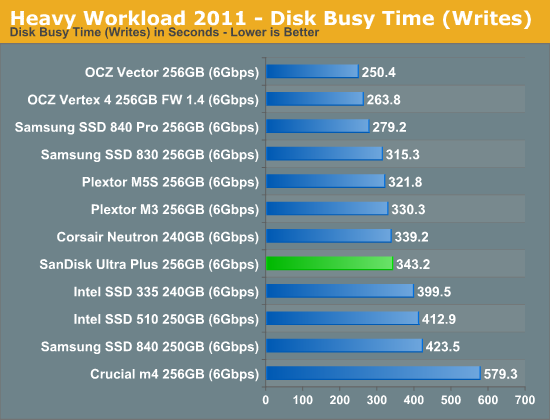










38 Comments
View All Comments
Samus - Monday, January 7, 2013 - link
I'm just dying for a mainstream Intel S3700 to hit the consumer corner...Beenthere - Monday, January 7, 2013 - link
Few if anyone would be able to differentiate a noticeable actual system performance change no matter which one of the listed SSDs they chose. SanDisk hasn't yet learned how to dupe the benches but in due time their numbers will increase similar to the others.If you're going to buy an SSD you should do your homework so you know the liabilities and realities including reliability and campatibility issues, lost data, drive size change, etc. If you want an eye opener read the warranties on SSDs at the respective SSD mfg. websites.
mrdude - Monday, January 7, 2013 - link
"The drive PCB itself is very small, potentially paving the way for some interesting, smaller-than-2.5" form factors."That's the most interesting bit, I find. Those things are absolutely tiny. So tiny that it kind of makes you wonder if standardizing the NGFF cards is even worth it going forward. If you need small storage then you can just stick with the standard SATA connectors on an itsy bitsy drive.
Very cool :)
vol7ron - Monday, January 7, 2013 - link
n-TB sizes that much more of a coming realitySmCaudata - Monday, January 7, 2013 - link
I picked up a SanDisk extreme 240 last year for about 50¢ per GB and I'm happy. Even during black Friday I didn't see anything cheaper and this drive is fast. The difference between most ssd now is academic. User experience is nearly the same for average consumers.mayankleoboy1 - Monday, January 7, 2013 - link
Isnt it the same that OCZ implemented in Vertex4 f/w 1.4 ?blowfish - Monday, January 7, 2013 - link
So for XP users, would a drive that doesn't support Trim be the way to go, since MS decided not to add Trim to XP in order to push Win7?randinspace - Monday, January 7, 2013 - link
Upgrading to Windows 7 (and pretending like 8 didn't happen even though it has enviable features...) is the way to go. Seriously speaking (upgrade), it's not like a drive that has TRIM support is going to be a bad thing even if you can't use it, but see the above comments about Sandforce controllers in general/Intel's 335 series SSDs in particular. Or even see the comments about hacking in TRIM support, IF YOU DARE!FWIW I'm very happy with the performance of my (240GB) 335. I'd probably buy another one to put in my laptop if they weren't going for $40 more than what I paid last month...
dave_the_nerd - Monday, January 7, 2013 - link
They all support TRIM. None REQUIRE it.If your OS doesn't support TRIM commands, you just have to find the drive with the best built-in GC routines. That used to be Sandforce, but I don't know anymore.
kmmatney - Monday, January 7, 2013 - link
With Samsung and Intel SSDs you can just run their toolbox software to do a manual TRIM. Iknow you can schedule it automatically with the Intel SSD Toolbox, and I think you can do that with the Samsung software as well. I've had a 40GB Intel SSD running on Windows XP for 2+ years and the TRIM scheduler works great.